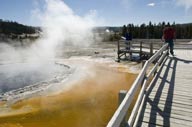 (ARTEL: West Brook, Maine) -- Yellowstone National Park has been selected as the location for Mission No. 2 of the ARTEL’s Extreme Pipetting Expedition. At Yellowstone, ARTEL will test how pipetting liquids at a temperature different than the pipette (thermal disequilibrium) affects delivered volume, and data accuracy and precision. While today’s laboratories are usually temperature-controlled, it’s very common to handle liquids that are extremely hot or cold. For example, restriction enzymes used in nucleic acid work are frequently handled at ice temperature (0° C), and higher temperatures are encountered with handling mammalian cell cultures (37° C) or polymerase chain reaction (PCR) solutions (60° C or higher).
(ARTEL: West Brook, Maine) -- Yellowstone National Park has been selected as the location for Mission No. 2 of the ARTEL’s Extreme Pipetting Expedition. At Yellowstone, ARTEL will test how pipetting liquids at a temperature different than the pipette (thermal disequilibrium) affects delivered volume, and data accuracy and precision. While today’s laboratories are usually temperature-controlled, it’s very common to handle liquids that are extremely hot or cold. For example, restriction enzymes used in nucleic acid work are frequently handled at ice temperature (0° C), and higher temperatures are encountered with handling mammalian cell cultures (37° C) or polymerase chain reaction (PCR) solutions (60° C or higher).
Because pipettes deliver different volumes when fluids are at different temperatures, laboratories need to account for the resulting volume variation. To draw attention to the importance of considering temperature disequilibrium in clinical testing, and help laboratories develop strategies to overcome this effect, ARTEL will release the results from mission No. 2 at the 2007 AACC Annual Meeting & Clinical Lab Expo, in San Diego, California, July 15-19.
…
Add new comment